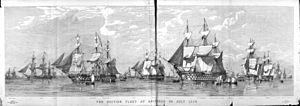HMS Highflyer (1851) facts for kids

Profile of Highflyer dated 1863
|
|
Quick facts for kids History |
|
|---|---|
| Name | HMS Highflyer |
| Ordered | 25 April 1847 |
| Builder | C J Mare & Co., Leamouth Wharf |
| Cost | £56,075 |
| Laid down | January 1850 |
| Launched | 13 August 1851 |
| Commissioned | 10 April 1852 |
| Fate | Broken up May 1871, at Portsmouth |
| General characteristics | |
| Class and type | Highflyer-class corvette |
| Displacement | 1,737 1⁄2 tons |
| Tons burthen | 1,153 bm |
| Length |
|
| Beam | 36 ft 4 in (11.07 m) |
| Draught | 15 ft 9 in (4.80 m) |
| Depth of hold | 22 ft 8 in (6.91 m) |
| Installed power | 702 ihp (523 kW) |
| Propulsion |
|
| Sail plan | Full-rigged ship |
| Speed | 9.4 kn (17.4 km/h) under steam |
| Armament |
|
HMS Highflyer was a special kind of warship called a frigate (and later a corvette) that belonged to the Royal Navy. It was made mostly of wood and used both sails and a steam engine to move. This ship was built on the River Thames and launched on August 13, 1851. Highflyer served for about 20 years, taking part in important events like the Crimean War and the Second Opium War. It was eventually taken apart in May 1871 in Portsmouth.
Contents
Building the Highflyer
Highflyer was designed to be a small wooden frigate. The plans for it were approved in November 1849. Building started in January 1850 at the C J Mare & Co. shipyard, which was located at Leamouth Wharf on the River Thames.
The ship was launched on August 18, 1851. It was officially ready for service on March 15, 1852, under the command of Captain Henry James Matson. Building the Highflyer cost a lot of money back then: about £27,105 for the main body, £17,431 for the engine, and £11,539 to get it ready for sea.
How the Ship Worked
Highflyer was designed to be a "screw corvette," which meant it could use both its sails and a steam engine. The main idea was for the ship to sail most of the time, but the steam engine was there to help when needed, like in calm waters or during battles.
The ship had a powerful two-cylinder steam engine built by Maudslay, Sons & Field. This engine turned a single propeller, allowing the ship to move through the water even without wind. It could reach a speed of about 9.4 knots (17.4 km/h) using its steam engine.
For sailing, Highflyer had a "full square sailing rig," meaning it had many large square sails on its masts, like a traditional sailing ship. This combination of sail and steam power was common for warships during that time.
Ship's Weapons
When Highflyer was first built, it carried 21 guns:
- One very large 10-inch gun (called an 84-pounder).
- Twenty smaller 32-pounder long guns.
Later, the ship's weapons were changed slightly. It still had the big 10-inch gun, but the other guns were replaced with 18 eight-inch guns. These guns were important for defending the ship and attacking enemies during conflicts.
Highflyer's Adventures at Sea
After being fully prepared for duty on April 10, 1852, Highflyer began its service.
Early Years and the Crimean War
Its first mission was with the North America and West Indies Station. Sadly, its first commander, Captain Matson, passed away in December 1852. Captain Edmund Heathcote then took over.

In April 1853, Captain John Moore became the ship's commander. Highflyer then joined the Mediterranean Fleet after taking part in a big Naval Review at Spithead. In 1854, the ship was sent to the Black Sea to fight in the Crimean War.
Highflyer was involved in the first day's attack on Sebastopol, a major port, on October 17, 1854.
Service in China
After the Crimean War, Highflyer was recommissioned (meaning it was prepared for new duties) on August 1, 1856, under Captain Charles Shadwell. It then sailed to the China Station to take part in the Second Opium War.
The ship was present when the city of Canton was captured in December 1857. It also participated in the Second Battle of Taku Forts on June 25, 1859. A famous person who served on Highflyer during this time was Midshipman John Fisher, who later became a very important admiral.
In January 1860, Captain William Andrew James Heath took command of the ship while it was still in the Far East.
Later Missions and Retirement
Highflyer returned to Portsmouth and was taken out of active service on May 31, 1861. However, it was recommissioned again on December 15, 1864, under Captain Thomas Malcolm Sabine Pasley. This time, it was sent to the Cape of Good Hope and East Indies areas.
The ship also served in the Persian Gulf. In January 1866, Highflyer fired its guns at a disputed fort in Al Zorah, which is in Ajman.
Highflyer was taken out of service for the last time on August 31, 1868. It was then taken apart in Portsmouth in May 1871, ending its long career.



